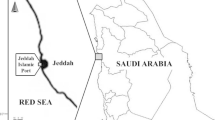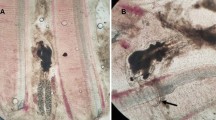Abstract
Dicyemid mesozoan parasites, microscopic organisms found with high intensities in the renal appendages of benthic cephalopods, have a complex, partially unknown life cycle. It is uncertain at which host life cycle stage (i.e. eggs, juvenile, adult) new infection by the dispersive infusoriform embryo occurs. As adult cephalopods have a short lifespan and die shortly after reproducing only once, and juveniles are fast-moving, we hypothesize that the eggs are the life cycle stage where new infection occurs. Eggs are abundant and sessile, allowing a huge number of new individuals to be infected with low energy costs, and they also provide dicyemids with the maximum amount of time for survival compared with infection of juvenile and adult stages. In our study we collected giant Australian cuttlefish (Sepia apama) eggs at different stages of development and filtered seawater samples from the S. apama mass breeding aggregation area in South Australia, Australia, and tested these samples for the presence of dicyemid DNA. We did not recover dicyemid parasite cytochrome c oxidase subunit I (COI) nucleotide sequences from any of the samples, suggesting eggs are not the stage where new infection occurs. To resolve this unknown in the dicyemid life cycle, we believe experimental infection is needed.
Similar content being viewed by others
References
Catalano S.R. 2012. A review of the families, genera and species of Dicyemida Van Beneden, 1876. Zootaxa, 3479, 1–32. DOI: z03479p032f.
Catalano S.R. 2013a. First descriptions of dicyemid mesozoans (Dicyemida: Dicyemidae) from Australian octopus (Octopodidae) and cuttlefish (Sepiidae) species, including a new record of Dicyemennea in Australian waters. Folia Parasitologica, 60, 306–320.
Catalano S.R. 2013b. Five new species of dicyemid mesozoans (Dicyemida: Dicyemidae) from two Australian cuttlefish species, with comments on dicyemid fauna composition relative to host size, calotte shape and host collection locality. Systematic Parasitology, 86, 125–151. DOI: 10.1007/s11230-013-9443-6.
Catalano S.R., Furuya H. 2013. Two new species of dicyemid (Dicyemida: Dicyemidae) from two Australian cephalopod species: Sepioteuthis australis (Mollusca: Cephalopoda: Loliginidae) and Sepioloidea lineolata (Mollusca: Cephalopoda: Sepiadariidae). Journal of Parasitology, 99, 203–211. DOI: 10.1645/GE-3252.1.
Cronin E.R., Seymour R.S. 2000. Respiration of the eggs of the giant cuttlefish Sepia apama. Marine Biology, 136, 863–870. DOI: 10.1007/s002270000274.
Drummond A.J., Ashton B., Buxton S., Cheung M., Cooper A., Heled J., Kearse M., Moir R., Stones-Havas S., Sturrock S., Thierer T., Wilson A. 2010. Geneious v5.3, Available from http://www.geneious.com.
Furuya H., Hochberg F.G., Tsuneki K. 2003. Reproductive traits in dicyemids. Marine Biology, 142, 693–706. DOI: 10.1007/s00227-002-0991-6.
Furuya H., Ota M., Kimura R., Tsuneki K. 2004. Renal organs of cephalopods: A habitat for dicyemids and chromidinids. Journal of Morphology, 262, 629–643. DOI: 10.1002/jmor.10265.
Hall K.C., Hanlon R.T. 2002. Principal features of the mating system of a large spawning aggregation of the giant Australian cuttlefish Sepia apama (Mollusca: Cephalopoda). Marine Biology, 140, 533–545. DOI: 10.1007/s00227-001-0718-0.
Kassahn K.S., Donnellan S.C., Fowler A.J., Hall K.C., Adams M., Shaw P.W. 2003. Molecular and morphological analyses of the cuttlefish Sepia apama indicate a complex population structure. Marine Biology, 143, 947–962. DOI: 10.1007/s00227-003-1141-5.
Lapan E.A., Morowitz H.J. 1975. The dicyemid Mesozoa as an integrated system for morphogenetic studies. 1. Description, isolation and maintenance. Journal of Experimental Zoology, 193, 147–160. DOI: 10.1002/jez.1401930204.
McConnaughey B.H. 1951. The life cycle of the dicyemid Mesozoa. University of California Press, Berkeley and Los Angeles, 55, 295–336.
Naud M., Hanlon R.T., Hall K.C., Shaw P.W., Havenhand J.N. 2004. Behavioural and genetic assessment of reproductive success in a spawning aggregation of the Australian giant cuttlefish, Sepia apama. Animal Behaviour, 67, 1043–1050. DOI: 10.1016/j.anbehav.2003.10.005.
Norman M.D., Finn J., Tregenza T. 1999. Female impersonation as an alternate reproductive strategy in giant cuttlefish. Proceedings of the Royal Society of London, 266, 1347–1349. DOI: 51624.
Semmens J.M., Pecl G.T., Gillanders B.M., Waluda C.M., Shea E.K., Jouffre D., Ichii T., Zumholz K., Katugin O.N., Leporati S.C., Shaw P.W. 2007. Approaches to resolving cephalopod movement and migration patterns. Reviews in Fish Biology and Fisheries, 17, 401–423. DOI: 10.1007/s11160-007-9048-8.
Watanabe K.I., Bessho Y., Kawasaki M., Hori, H. 1999. Mitochondrial genes are found on minicircle DNA molecules in the mesozoan animal Dicyema. Journal of Molecular Biology, 286, 645–650. DOI: 10.1006/jmbi.1998.2523.
Author information
Authors and Affiliations
Corresponding author
Rights and permissions
About this article
Cite this article
Catalano, S.R., Whittington, I.D., Donnellan, S.C. et al. Using the giant Australian cuttlefish (Sepia apama) mass breeding aggregation to explore the life cycle of dicyemid parasites. Acta Parasit. 58, 599–602 (2013). https://doi.org/10.2478/s11686-013-0186-y
Accepted:
Published:
Issue Date:
DOI: https://doi.org/10.2478/s11686-013-0186-y




